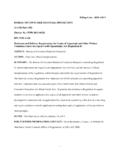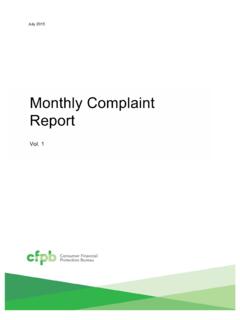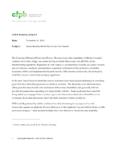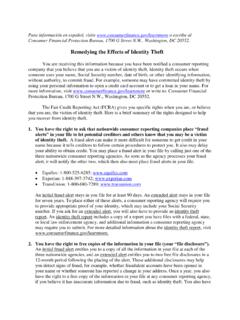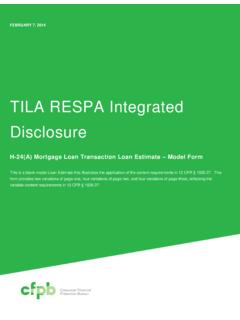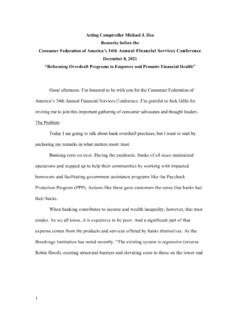Transcription of LIBOR Transition FAQs 1 - Consumer Financial Protection …
1 VERSION 2 | LAST UPDATED 12/7/2021. LIBOR Transition FAQs 1. The questions and answers below pertain to compliance with bureau regulations for Consumer Financial products and services impacted by the anticipated LIBOR discontinuation and resulting need to Transition to other indices. The guidance addresses bureau regulatory requirements for both existing accounts and new originations as they complete the steps necessary to discontinue use of LIBOR . Other legal requirements may also apply. All Consumer Financial Products and Services NOTE: The questions and answers in this section apply to all Consumer Financial products and services impacted by the LIBOR Transition . QUESTION 1: What is the LIBOR Transition ?
2 ANSWER (UPDATED 12/7/2021): The LIBOR Transition references both the anticipated discontinuation of LIBOR (and LIBOR - based indices), as well as the preparations Financial institutions, government agencies, and other entities are making to Transition businesses from LIBOR -based indices. On June 30, 2023, the last tenors of USD LIBOR ( LIBOR ) are expected to end. This change will affect some adjustable (or variable) rate loans and lines of credit, such as adjustable-rate This is a Compliance Aid issued by the Consumer Financial Protection bureau . The bureau published a Policy Statement on Compliance Aids, available at rules/policy-statement-compliance-aids/, that explains the bureau 's approach to Compliance Aids.
3 1 LIBOR Transition FAQS. VERSION 2 | LAST UPDATED 12/7/2021. mortgages (ARMs), reverse mortgages, home equity lines of credit (HELOCs), credit cards, student loans, and any other Consumer loans that use LIBOR as the index. For Consumer Financial products and services, Financial entities are developing their approach to the LIBOR . Transition , including how to Transition existing accounts from LIBOR to another index and selecting new indices for new originations going forward. In the , the Federal Reserve has convened a group called the Alternative Reference Rates Committee (ARRC) to help facilitate the likely Transition away from the use of LIBOR as an index. The ARRC is comprised of a diverse set of private-sector entities in markets affected by LIBOR , and a wide array of official-sector entities, including banking and Financial sector regulators (such as the bureau ) as non-voting, ex-officio members.
4 The ARRC has identified the steps industries need to complete for the Transition , such as making contract revision and replacement index selection recommendations. More information about the LIBOR Transition and ARRC recommendations on preparing for the Transition can be found on the ARRC's website. The bureau provided the FAQs below to address regulatory provisions affected by the LIBOR . Transition and published a final rule to address regulatory changes needed for the Transition ( LIBOR Transition Rule). QUESTION 2: Are there specific regulatory or statutory requirements creditors need to consider as they prepare to Transition impacted consumers away from the LIBOR index? ANSWER (UPDATED 12/7/2021): Yes.
5 Creditors have regulatory and statutory requirements impacted or triggered by the LIBOR . Transition for both new and existing Consumer accounts. For certain Consumer Financial products and services, statutes and regulations may have specific requirements that are triggered or impacted by the LIBOR Transition and any accompanying index change. For example, Regulation Z has requirements for certain products regarding Consumer notification of a change to the contract terms, limits on when the index can change, and requirements for selecting an appropriate replacement index. Additionally, creditors will want to be cognizant of other standard regulatory and statutory requirements, such as prohibitions in the Dodd-Frank Act on unfair, deceptive, or abusive acts or practices, and continue to follow their normal business practices in assessing and mitigating risk in those areas while completing the LIBOR .
6 Transition . 2 LIBOR Transition FAQS. VERSION 2 | LAST UPDATED 12/7/2021. The following list highlights certain bureau regulatory provisions impacted by the LIBOR . Transition . Creditors and card issuers of variable-rate products using LIBOR as an index will want to consider these identified provisions, as well as other federal and state requirements and guidance , when making any LIBOR -related changes to the Consumer 's index or other loan terms. CLOSED-END PRODUCTS AND SERVICES. 1) Adjustable-Rate Mortgages: Origination disclosure requirements for the adjustable-rate loan program disclosure, particularly the loan program example (12 CFR (b)(2));. Refinancing provisions governing whether changing to a particular replacement index is considered a refinancing, and triggering, for example, new transaction disclosures and new ATR/QM determinations, as applicable (12 CFR (a); Comments 20(a) and ).
7 Servicing disclosure requirements on the content and format of mortgage servicing notices, such as interest rate adjustment notices and periodic statements (12 CFR. (c), (d), and .41, as well as Appendix H-4(D)); and For alternative mortgage transaction ARMs, limitations on increasing the interest rate or finance charge (12 CFR (a)(2)). 2) Private Student Loans: Refinancing provisions governing whether changing to a particular replacement index is considered a refinancing and triggering, for example, new transaction disclosures, as applicable (12 CFR (a); Comments 20(a) and ). 3) Other Closed-End Products and Services ( , Auto Loans, Personal Installment Loans): Refinancing provisions governing whether changing to a particular replacement index is considered a refinancing and triggering, for example, new transaction disclosures, as applicable (12 CFR (a); Comments 20(a) and ).
8 OPEN-END PRODUCTS AND SERVICES. 1) Credit Cards: 3 LIBOR Transition FAQS. VERSION 2 | LAST UPDATED 12/7/2021. Index change requirements, including limitations on changing the index used to determine the annual percentage rate (APR) for variable rate accounts and the requirements for identifying a replacement index, as well as LIBOR -specific provisions (12 CFR (b)(2) and 55(b)(7));. Change-in-terms notice requirements (12 CFR (c)(2)); and Reevaluations of rate increases and the index used as a benchmark for comparison, including LIBOR -specific exceptions (12 CFR ). 2) HELOCs (including Open-End Reverse Mortgages): Index change requirements, including limitations on changing an index and the requirements for identifying a replacement index, as well as LIBOR -specific provisions (12 CFR (f)(1) and 40(f)(3)(ii)).
9 Change-in-terms notice requirements (12 CFR (c)(1));. Application Disclosure requirements, particularly the loan program example (12 CFR. (d)(12)); and For alternative mortgage transaction HELOCs, limitations on increasing the interest rate or finance charge (12 CFR (a)). 3) Other Open-End (not Home-Secured) Products and Services ( , overdraft lines of credit): Change-in-terms notice requirements (12 CFR (c)(2)). These regulatory provisions are discussed in greater detail in the FAQs below. QUESTION 3: What is the bureau 's LIBOR Transition Rule? ANSWER (UPDATED 12/7/2021): On June 4, 2020, in anticipation of the LIBOR sunset date, the bureau published a proposed rule, which submitted amendments to certain existing Regulation Z requirements to facilitate the LIBOR Transition for public comment.
10 On December 7, 2021, the bureau finalized that Rule, largely as proposed. In the final rule (the LIBOR Transition Rule), the bureau : 4 LIBOR Transition FAQS. VERSION 2 | LAST UPDATED 12/7/2021. Amended open-end and closed-end provisions to provide examples of replacement indices for LIBOR indices that meet certain Regulation Z conditions. Amended Regulation Z to permit HELOC creditors and credit card issuers to Transition existing accounts that use a LIBOR index to a replacement index on or after April 1, 2022, if certain conditions are met. Amended HELOC and credit card change-in-terms notice provisions and explained how they apply to accounts transitioning away from using a LIBOR index.

